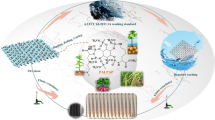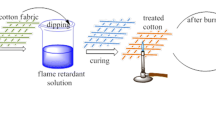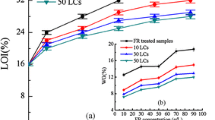Abstract
A novel biomass-based, phosphorus-nitrogen-based, halogen-free flame retardant, ammonium salts of polylysine methylphosphonate glycerol ester (PLUEG), was successfully synthesized based on ε-polylysine and glycerol, used to prepare highly efficient and durable flame-retardant cotton fabrics. The large number of –P=O(O−NH4+)2 reactive groups improved the binding between flame retardants and cotton fabrics, making it harder for flame retardants to be washed off from cotton fabrics. During the synthesis process, some of the –P=O(OH) groups on flame retardants were esterified in advance with glycerol, to reduce the effect of metal ions on the flame retardancy of cotton fabrics during washing process. And cotton fabrics were pretreated with sodium hydroxide to partly break the crystalline region of cellulose and increase the number of reacting sites in cellulose for flame retardants. After the pretreatment with sodium hydroxide and treatment with PLUEG, cotton fabrics with high flame retardancy and durability was prepared. The limiting oxygen index value of cotton fabrics increased to 42.7%, which remained at 28.6% after 50 laundering cycles (LCs) of home machine washes. Analysis by Fourier-transform infrared spectroscopy (FTIR) and energy-dispersive X-ray spectroscopy revealed that PLUEG were bound to cotton fabrics by –P(=O)–O–C bonds, and the flame retardancy of treated cotton fabrics decreased during washing process because of the replacement of NH4+ in unreacted –P=O(O−NH4+)2 groups by the metal ions in washing liquid. Also, analysis by thermogravimetric (TG), TG-FTIR spectroscopy and scanning electron microscopy indicated that PLUEG was mainly effective in the condensed phase. The whiteness and mechanical properties of treated cotton fabrics were retained well.
Graphic abstract










Similar content being viewed by others
References
Abou-Okeil A, Ei-Sawy SM, Abdel-Mohdy FA (2013) Flame retardant cotton fabrics treated with organophosphorus polymer. Carbohydr Polym 92:2293–2298. https://doi.org/10.1016/j.carbpol.2012.12.008
Alongi J, Malucelli G (2012) State of the art and perspectives on sol–gel derived hybrid architectures for flame retardancy of textiles. J Mater Chem 22:21805–21809. https://doi.org/10.1039/c2jm32513f
Alongi J, Carletto RA, Blasio AD, Carosio F, Bosco F, Malucelli G (2013a) DNA: a novel, green, natural flame retardant and suppressant for cotton. J Mater Chem A 1:4779–4785. https://doi.org/10.1039/c3ta00107e
Alongi J, Carletto RA, Blasion AD, Cuttica F, Carosio F, Bosco F, Malucelli G (2013b) Intrinsic intumescent-like flame retardant properties of DNA-treated cotton fabrics. Carbohydr Polym 96:296–304. https://doi.org/10.1016/j.carbpol.2013.03.066
Alongi J, Carletto RA, Bosco F, Carosio F, Blasio DA, Cuttica F, Antonucci V, Giordano M, Malucelli G (2014) Caseins and hydrophobins as novel green flame retardants for cotton fabrics. Polym Degrad Stabil 99:111–117. https://doi.org/10.1016/j.polymdegradstab.2013.11.016
Bao LH, Li XD (2012) Towards textile energy storage from cotton T-shirts. Adv Mater 24:3246–3252. https://doi.org/10.1002/adma.201200246
Basak S, Ali SW (2016) Sustainable fire retardancy of textiles using bio-macromolecules. Polym Degrad Stabil 133:47–64. https://doi.org/10.1016/j.polymdegradstab.2016.07.019
Basak S, Saxena S, Chattopadhyay SK, Narkar R (2016) Banana pseudostem sap: a waste plant resource for making thermally stable cellulosic substrate. J Ind Text 46:1003–1023. https://doi.org/10.1177/1528083715591580
Basak S, Samanta KK, Saxena S, Chattopadhyay SK, Parmar MS (2017) Self-extinguishable cellulosic textile from Spinacia oleracea. Indian J Fiber Text 42:215–222
Bosco F, Carletto RA, Alongi J, Marmo L, Blasio DA, Malucelli G (2013) Thermal stability and flame resistance of cotton fabrics treated with whey proteins. Carbohydr Polym 94:372–377. https://doi.org/10.1016/j.carbpol.2012.12.075
Carosio F, Blasio AD, Alongi J, Malucelli G (2013) Green DNA-based flame retardant coatings assembled through layer by layer. Polymer 54:5148–5153. https://doi.org/10.1016/j.polymer.2013.07.029
Carosio F, Blasio AD, Cuttica F, Alongi J, Malucelli G (2014) Flame retardancy of polyester and polyester-cotton blends treated with caseins. Ind Eng Chem Res 53:3917–3923. https://doi.org/10.1021/ie404089t
Cheema HA, El-Shafei A, Hauser PJ (2013) Conferring flame retardancy on cotton using novel halogen-free flame retardant bifunctional monomers: synthesis, characterizations and applications. Carbohydr Polym 92:885–893. https://doi.org/10.1016/j.carbpol.2012.09.081
Costes L, Laoutid F, Brohez S, Dubois P (2017) Bio-based flame retardants: When nature meets fire protection. Mater Sci Eng R 117:1–25. https://doi.org/10.1016/j.mser.2017.04.001
Deng B, Cai R, Yu Y, Jiang H, Wang C, Li J, Li L, Yu M, Li J, Xie L, Huang Q, Fan C (2010) Laundering durability of superhydrophobic cotton fabric. Adv Mater 22:5473–5477. https://doi.org/10.1002/adma.201002614
Feng YJ, Zhou Y, Li DK, He S, Zhang FX, Zhang GX (2017) A plant-based reactive ammonium phytate for use as a flame-retardant for cotton fabric. Carbohydr Polym 175:636–644. https://doi.org/10.1016/j.carbpol.2017.06.129
Gao WW, Zhang GX, Zhang FX (2015) Enhancement of flame retardancy of cotton fabrics by grafting a novel organic phosphorous-based flame retardant. Cellulose 22:2787–2796. https://doi.org/10.1007/s10570-015-0641-z
Gao DG, Zhang YH, Lyu B, Wang PP, Ma JZ (2019) Nanocomposite based on poly(acrylic acid)/attapulgite towards flame retardant of cotton fabrics. Carbohydr Polym 206:245–253. https://doi.org/10.1016/j.carbpol.2018.10.113
Hosomi R, Yamamoto D, Otsuka R, Nishiyama T, Yoshida M, Fukunaga K (2015) Dietary ε-polylysine decreased serum and liver lipid contents by enhancing fecal lipid excretion irrespective of increased hepatic fatty acid biosynthesis-related enzymes activities in rats. Nutr Food Sci 20:43–51. https://doi.org/10.3746/pnf.2015.20.1.43
Liu YY, Wang XW, Qi KH, Xin JH (2008) Functionalization of cotton with carbon nanotubes. J Mater Chem 18:3454–3460. https://doi.org/10.1039/b801849a
Liu W, Chen L, Wang YZ (2012) A novel phosphorus-containing flame retardant for the formaldehyde-free treatment of cotton fabrics. Polym Degrad Stabil 97:2487–2491. https://doi.org/10.1016/j.polymdegradstab.2012.07.016
Malucelli G, Bosco F, Alongi J, Carosio F, Blasio DA, Mollea C, Cuttica F, Casale A (2014) Biomacromolecules as novel green flame retardant systems for textiles: an overview. RSC Adv 4:46024–46039. https://doi.org/10.1039/c4ra06771a
Mayer-Gall T, Knittel D, Gutmann JS, Opwis K (2015) Permanent flame retardant finishing of textiles by allyl-functionalized polyphosphazenes. ACS Appl Mater Interfaces 7:9349–9363. https://doi.org/10.1021/acsami.5b02141
Poon CK, Kan CW (2015) Effects of TiO2 and curing temperatures on flame retardant finishing of cotton. Carbohydr Polym 121:457–467. https://doi.org/10.1016/j.carbpol.2014.11.064
Shariatinia Z, Javeri N, Shekarriz S (2015) Flame retardant cotton fibers produced using novel synthesized halogen-free phosphoramide nanoparticles. Carbohydr Polym 118:183–198. https://doi.org/10.1016/j.carbpol.2014.11.039
Sjodin A, Patterson DG, Bergman A (2003) A review on human exposure to brominated flame retardants- particularly polybrominated diphenyl ether. Environ Int 29:829–839. https://doi.org/10.1016/S0160-4120(03)00108-9
Torre C, Dominguez-Berrocal L, Murguia JR, Marcos MD, Martinez-Manez R, Bravo J, Sancenon F (2018) epsilon-Polylysine-capped mesoporous silica nanoparticles as carrier of the C9h peptide to induce apoptosis in cancer cells. Chem Eur J 24:1890–1897. https://doi.org/10.1002/chem.201704161
Wu MC, Ma BH, Pan TZ, Chen SS, Sun JQ (2016) Silver-nanoparticle-colored cotton fabrics with tunable colors and durable antibacterial and self-healing superhydrophobic properties. Adv Funct Mater 26:569–576. https://doi.org/10.1002/adfm.201504197
Xu LJ, Wang W, Yu D (2017) Preparation of a reactive flame retardant and its finishing on cotton fabrics based on click chemistry. RSC Adv 7:2044–2050. https://doi.org/10.1039/c6ra26075f
Xu B, Wu X, Ma W, Qian L, Xin F, Qiu Y (2018) Synthesis and characterization of a novel organic-inorganic hybrid char-forming agent and its flame-retardant application in polypropylene composites. J Anal Appl Pyrol 134:231–242
Xu F, Zhong L, Xu Y, Zhang C, Zhang FX, Zhang GX (2019a) Highly efficient flame-retardant and soft cotton fabric prepared by a novel reactive flame retardant. Cellulose 26:4225–4240. https://doi.org/10.1007/s10570-019-02374-4
Xu F, Zhong L, Xu Y, Zhang C, Wang P, Zhang FX, Zhang GX (2019b) Synthesis of three novel amino acids-based flame retardants with multiple reactive groups for cotton fabrics. Cellulose 26:7537–7552. https://doi.org/10.1007/s10570-019-02599-3
Xu F, Zhong L, Zhang C, Wang P, Zhang FX, Zhang GX (2019c) Novel high-efficiency casein-based P-N-containing flame retardants with multiple reactive groups for cotton fabrics. ACS Sustain Chem Eng 7:13999–14008.
Zhang FX, Gao WW, Jia YL, Lu Y, Zhang GX (2018) A concise water-solvent synthesis of highly effective, durable, and eco-friendly flame-retardant coating on cotton fabrics. Carbohydr Polym 199:256–265. https://doi.org/10.1016/j.carbpol.2018.05.085
Zheng DD, Zhou JF, Zhong L, Zhang FX, Zhang GX (2016) A novel durable and high-phosphorous-containing flame retardant for cotton fabrics. Cellulose 23:2211–2220. https://doi.org/10.1007/s10570-016-0949-3
Zhu HX, Jia SR, Yang HJ, Tang WH, Jia YY, Tan ZL (2010) Characterization of bacteriostatic sausage casing: a composite of bacterial cellulose embedded with ε-polylysine. Food Sci Biotechnol 19:1479–1484. https://doi.org/10.1007/s10068-010-0211-y
Acknowledgements
This work was supported by the Research Foundation for Youth Scholars of Beijing Technology and Business University (Grant No. QNJJ2021-20), the Natural Science Foundation of Chongqing (Grant No. cstc2019jcyj-msxmX0412) and the National Natural Science Foundation of China (Grant No. 21905233).
Author information
Authors and Affiliations
Corresponding author
Ethics declarations
Conflict of interest
The authors declare no conflict of interest.
Additional information
Publisher’s note
Springer Nature remains neutral with regard to jurisdictional claims in published maps and institutional affiliations.
Rights and permissions
About this article
Cite this article
Xu, F., Zhang, G., Wang, P. et al. A novel ε-polylysine-derived durable phosphorus‐nitrogen‐based flame retardant for cotton fabrics. Cellulose 28, 3807–3822 (2021). https://doi.org/10.1007/s10570-021-03714-z
Received:
Revised:
Accepted:
Published:
Issue Date:
DOI: https://doi.org/10.1007/s10570-021-03714-z




